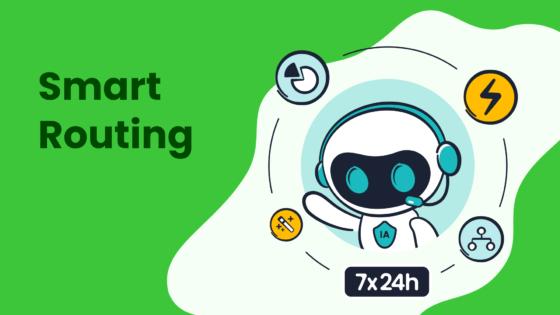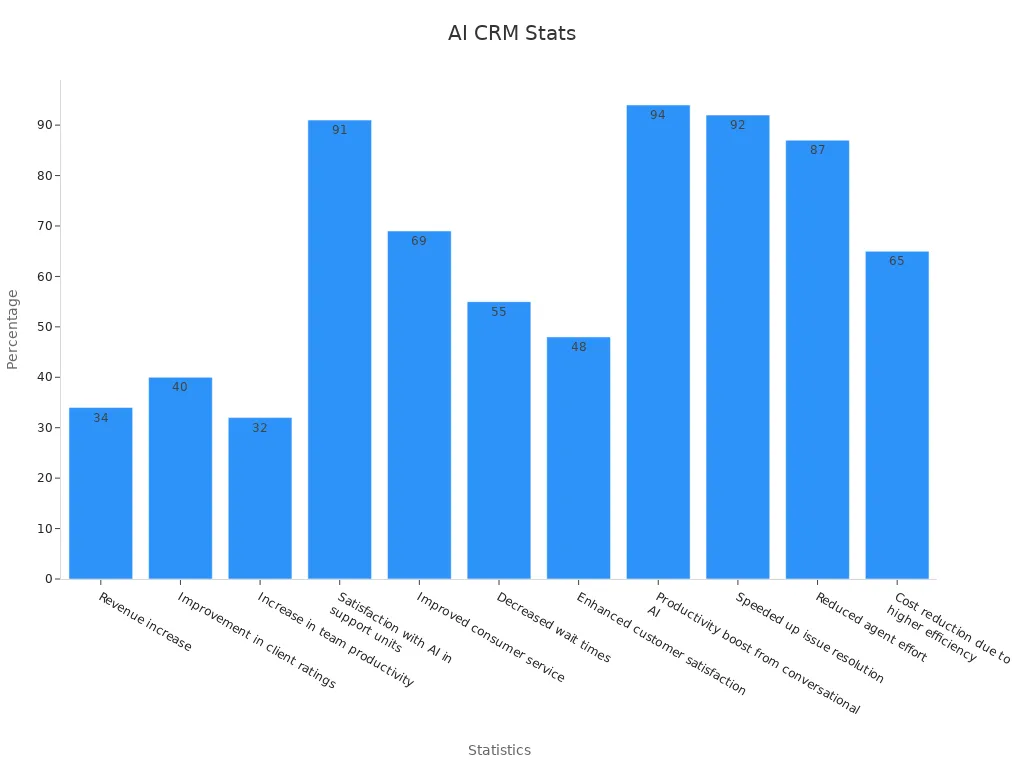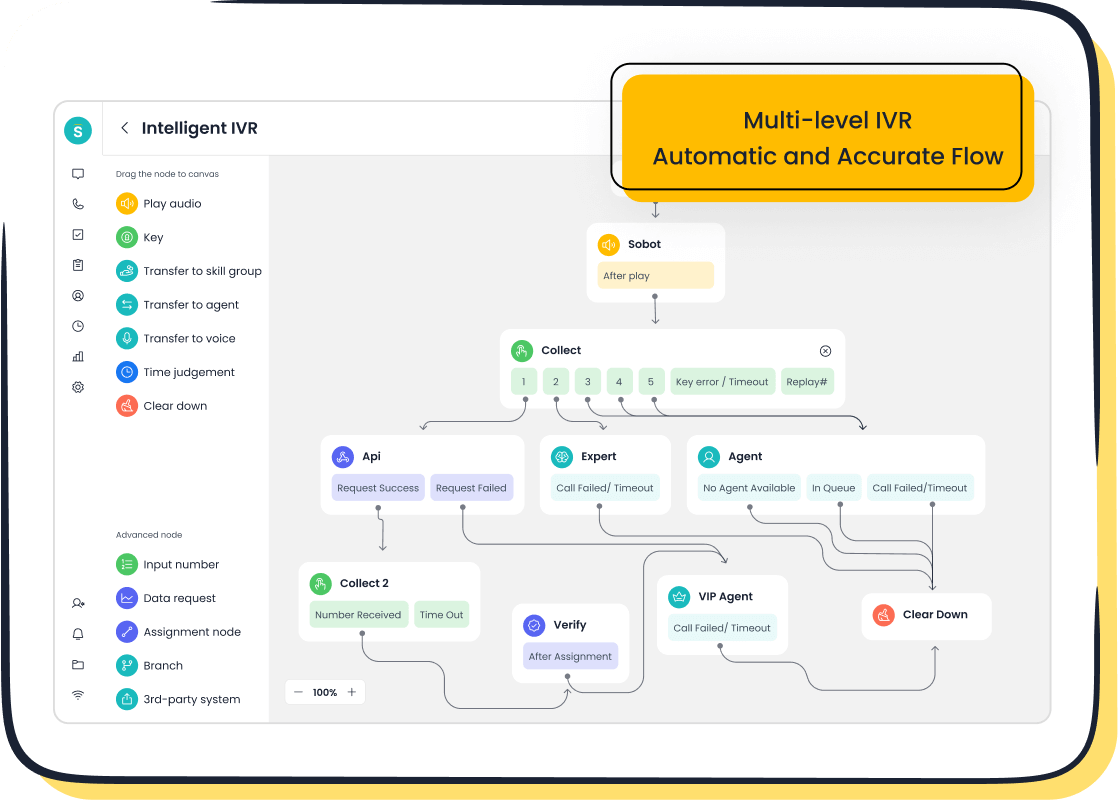How Contact Center CRM Software Works and Integrates Tools

Contact center CRM software plays a transformative role in modern customer service. It helps businesses manage interactions, streamline operations, and improve customer satisfaction. Studies show that companies using CRM tools see a 27% increase in customer retention and a 53% improvement in support quality. These tools also boost conversion rates by up to 300%, demonstrating their impact on business growth.
Integration with other tools is vital for seamless operations. It enhances data visibility, empowering agents to deliver personalized service. For example, integrating call center dashboards with CRM improves performance and customer experiences.

Sobot exemplifies advanced solutions in this field. Its Voice/Call Center software simplifies communication with features like smart call routing, AI-powered voicebots, and global number availability. With a 99.99% system uptime, it ensures reliable and efficient customer interactions.
Understanding Contact Center CRM Software
What Is Contact Center CRM Software?
Contact center CRM software is a tool that helps you manage customer interactions across various communication channels. It combines customer relationship management with contact center software to streamline operations and improve service quality. By using this software, you can track customer data, monitor interactions, and provide personalized support.
The global contact center software market was valued at USD 33.38 billion in 2023 and is expected to grow at a CAGR of 23.9% from 2023 to 2030. This growth reflects the increasing demand for better customer experiences and the rise of omnichannel communication. Businesses like yours can benefit from this trend by adopting advanced CRM tools.
Core Functionalities of Contact Center CRM
Contact center CRM software offers several core functionalities that enhance your operations:
- Omnichannel Support: Manage customer interactions across voice, email, chat, and social media from a single platform.
- Automation: Automate repetitive tasks like ticket creation and call routing to save time.
- Data Analytics: Gain insights into customer behavior and agent performance through detailed reports.
- AI Integration: Use AI-powered tools to improve response times and accuracy.
| Statistic | Description |
|---|---|
| 68% | Customer service leaders use a CRM in their operations. |
| 67% | Support leaders see value from automation efforts. |
| 84% | Customer service reps find AI makes responding to tickets easier. |
| 80% | Executives report improvements in customer satisfaction due to AI. |

Sobot's Voice/Call Center solution exemplifies these functionalities. It offers features like smart call routing, AI-powered voicebots, and real-time analytics, ensuring efficient and reliable customer service.
Features That Enhance Customer Interactions
Modern contact center CRM software includes features designed to improve customer satisfaction. These features help you deliver personalized and efficient service:
- Unified Customer Data: Access all customer information in one place for better decision-making.
- Self-Service Options: Enable customers to resolve issues independently through AI-powered chatbots.
- Proactive Engagement: Use tools like WhatsApp API to send personalized messages and updates.
| Statistic | Insight |
|---|---|
| 73% of consumers | Will switch to a competitor after multiple bad experiences. |
| 79% of customers | Will switch brands if they find a competitor with a better experience. |
| 70% of CX leaders | Say generative AI improves digital customer interactions. |
For example, a leading telecom company used text analytics to identify pain points in customer interactions. By integrating automation, they reduced response times and lowered churn rates by 30%. Sobot's solutions, like its AI-powered Voice/Call Center, help businesses achieve similar results by enhancing customer interactions and satisfaction.
How Contact Center CRM Software Works

Managing Customer Interactions Efficiently
Efficiently managing customer interactions is the cornerstone of any successful contact center CRM. By centralizing communication channels, you can ensure that every interaction is tracked and resolved promptly. This approach not only improves response times but also enhances customer satisfaction. For instance, metrics like response time and operational efficiency directly reflect how well your team handles inquiries.
| Metric | Description |
|---|---|
| Response Time | A key performance indicator that reflects the efficiency of customer service interactions. |
| Customer Satisfaction | Directly correlates with response times; faster responses lead to higher satisfaction levels. |
| Brand Perception | Efficient response times contribute to a positive brand image and customer loyalty. |
| Operational Efficiency | Measured by response times; indicates how well agencies manage customer interactions. |
| Client Retention | Faster response times can enhance client retention and attract new business opportunities. |

Sobot's Voice/Call Center solution exemplifies this efficiency. Its unified workspace allows agents to access accurate customer interactions and data in real time, ensuring personalized interactions. Features like smart call routing and AI-powered voicebots further streamline the process, reducing wait times and improving first-contact resolution rates.
Did you know? Exceptional customer service is essential for brand loyalty and business growth. The call center industry is rapidly growing due to increasing demand for customer service.
Streamlining Workflows with Automation
Workflow automation transforms how you handle repetitive tasks, enabling your team to focus on more complex customer needs. By automating processes like ticket creation, call routing, and follow-ups, you can significantly boost productivity and reduce errors. Companies like Siemens and Honeywell have demonstrated the impact of automation through metrics such as Overall Equipment Effectiveness (OEE) and customer order fulfillment rates.
- Overall Equipment Effectiveness (OEE): Tracks efficiency gains by monitoring downtime, speed losses, and quality.
- Customer Order Fulfillment Rates: Identifies areas for improvement in automated processes.
- Inventory Turnover: Maintains a competitive edge by optimizing inventory management post-automation.
Sobot's workflow automation capabilities stand out in the industry. Its Voice/Call Center software automates outbound tasks, assigns leads based on priorities, and integrates seamlessly with existing systems. These features not only save time but also ensure that your team delivers consistent and high-quality service.
The Role of AI in Modern CRM Systems
Artificial intelligence (AI) has revolutionized CRM systems, making them smarter and more efficient. AI-powered tools analyze customer data, predict behavior, and provide actionable insights. This allows you to personalize interactions and resolve issues faster. Statistics reveal the transformative impact of AI:
| Statistic | Percentage |
|---|---|
| Revenue increase | 34% |
| Improvement in client ratings | 40% |
| Increase in team productivity | 32% |
| Satisfaction with AI in support units | 91% |
| Improved consumer service | 69% |
| Decreased wait times | 55% |
| Enhanced customer satisfaction | 48% |
| Productivity boost from conversational AI | 94% |
| Speeded up issue resolution | 92% |
| Reduced agent effort | 87% |
| Cost reduction due to higher efficiency | 65% |

Sobot integrates AI into its Voice/Call Center solution through features like AI-powered voicebots and real-time analytics. These tools enhance customer satisfaction by reducing wait times and improving the accuracy of responses. With AI, you can achieve faster resolutions and lower operational costs, making your contact center CRM a powerful asset.
Integration of Contact Center CRM Software with Other Tools

Native Integrations vs. Third-Party Integrations
When integrating contact center software with other tools, you often encounter two options: native integrations and third-party integrations. Native integrations are built directly into the software, offering seamless compatibility and faster setup. For example, platforms like Salesforce and Shopify provide native integrations through their app stores, making it easy to connect with other systems. These integrations ensure smooth data flow and reduce the need for additional customization.
On the other hand, third-party integrations rely on external tools like Zapier to connect different systems. While these can be highly flexible, they may require more time and resources to configure. Some platforms, such as Webex Contact Center, limit third-party integration options, which can restrict functionality. Similarly, Talkdesk users have reported challenges with third-party partnerships, leading to higher costs and longer development times for custom solutions.

Choosing between native and third-party integrations depends on your business needs. Native integrations work well for standard use cases, while third-party tools offer greater flexibility for unique requirements. Sobot’s Voice/Call Center solution supports both, ensuring you can integrate your CRM with ease, regardless of your preference.
Tools Commonly Integrated with Contact Center CRM
Integrating call center technology with other tools enhances the functionality of your CRM and improves customer service. Some of the most commonly integrated tools include:
- Customer Relationship Management (CRM) Systems: Tools like Salesforce and HubSpot help you manage customer data and interactions efficiently.
- Marketing Automation Platforms: These tools, such as Mailchimp or Marketo, enable personalized marketing campaigns based on customer behavior.
- Help Desk Software: Integrating with ticketing systems streamlines issue resolution and improves agent productivity.
- E-commerce Platforms: Shopify and Magento integrations allow you to track customer orders and provide better support.
- Analytics Tools: Platforms like Google Analytics or Tableau provide insights into customer behavior and agent performance.
Integration with these tools offers several benefits. For instance, connecting your CRM with marketing automation platforms enables proactive customer engagement. Similarly, integrating analytics tools provides real-time access to customer data, helping you make informed decisions. According to studies, integration improves metrics like customer satisfaction, agent productivity, and first-call resolution rates.
| Metric | Description |
|---|---|
| Customer Satisfaction | Integration allows for personalized service, reducing customer effort and increasing satisfaction. |
| Agent Productivity | Agents can serve customers more efficiently with all necessary information readily available. |
| Average Handle Time | Shortened call lengths are achieved by identifying customers before interactions, leading to quicker resolutions. |
| Wait Time | Reduced average handle time leads to shorter wait times for customers to connect with agents. |
| First Call Resolution Rate | Using CRM data to connect customers to the right agent increases the likelihood of resolving issues in a single call. |
Sobot’s Voice/Call Center solution supports integration with these tools, ensuring your contact center operates efficiently and delivers exceptional customer experiences.
How Sobot Voice/Call Center Simplifies Integration
Sobot’s Voice/Call Center software makes integration with other tools straightforward and effective. Its robust integration options connect seamlessly with existing CRM systems, marketing platforms, and analytics tools. This ensures you can unify your operations without technical hurdles.
The platform’s user-friendly interface simplifies the setup process, allowing you to integrate tools quickly. Features like AI-powered customer support and advanced natural language processing (NLP) capabilities enhance customer interactions. For example, Sobot’s machine learning algorithms continuously improve chatbot performance, while its analytics dashboard provides actionable insights into customer behavior.
| Feature | Description |
|---|---|
| AI-Powered Customer Support | Streamlines and enhances customer interactions for businesses of all sizes. |
| Advanced NLP Capabilities | Enables chatbots to understand and respond to customer queries accurately. |
| Robust Integration Options | Connects with existing CRM systems and third-party tools. |
| Analytics Dashboard | Offers insights into customer interactions and tracks key performance metrics. |
Sobot also supports multi-language capabilities, making it ideal for global businesses. Its proactive customer engagement tools initiate conversations based on user behavior, ensuring you stay ahead of customer needs. By integrating Sobot’s Voice/Call Center with your existing systems, you can achieve faster resolutions, higher customer satisfaction, and improved operational efficiency.
Tip: If you’re wondering how to integrate CRM with your contact center software, start by identifying the tools you use most frequently. Then, choose a solution like Sobot that supports seamless integration with those tools.
Benefits of Integrating CRM Software with Other Tools
Enhancing Customer Experience Through Unified Data
Integrating CRM software with other tools creates a unified data platform that transforms how you manage customer interactions. By consolidating customer information from multiple sources, you gain a complete view of their preferences, history, and needs. This unified approach allows you to deliver personalized service, boosting customer satisfaction and loyalty. For example, CRM systems provide valuable insights into customer behavior, enabling better targeting and identification of marketing trends.
Unified data also ensures consistency across channels, which is essential for boosting customer experience. Studies show that 65% of customers expect instant responses from brands, and CRM integration helps meet these expectations. With tools like Sobot’s Voice/Call Center, you can access real-time customer data, enabling faster resolutions and proactive engagement. This integration leads to higher satisfaction ratings and improved customer retention.
Note: By 2025, AI is projected to manage 95% of customer interactions, further enhancing the efficiency of CRM systems.
Boosting Agent Productivity with Streamlined Processes
Streamlined processes significantly improve agent productivity. When you integrate CRM software with contact center tools, agents can access all necessary information in one place, reducing the time spent switching between systems. Metrics like first contact resolution and occupancy rate highlight the impact of these streamlined workflows.
| Metric | Description |
|---|---|
| First Contact Resolution | Measures the ability to resolve customer issues on the first interaction, reducing the need for multiple contacts. |
| Occupancy Rate | Indicates the proportion of time agents spend on interactions versus being idle, reflecting overall productivity. |
| Customer Experience | Assesses customer satisfaction, which is crucial for evaluating the effectiveness of contact center support. |
Sobot’s Voice/Call Center software exemplifies this efficiency. Its unified workspace and automation features, such as outbound task management, help agents focus on complex customer needs. Case studies show that streamlined processes lead to significant improvements, such as a 67% increase in productivity for real estate brokerages and a 74% improvement in occupancy rates for service providers.
Leveraging Unified Analytics for Better Decision-Making
Unified analytics from integrated CRM systems empower you to make informed decisions. By consolidating data sources, you gain a holistic view of your operations, reducing inconsistencies and improving accuracy. Decision-makers can rely on a single source of truth, ensuring strategies are based on reliable data.
- Streamlining data processes makes information more accessible, driving better decision-making across the organization.
- Unified data offers insights into market trends, helping you identify customer behavior patterns.
- Accurate performance metrics across departments lead to better resource optimization and ROI.
Sobot’s analytics dashboard provides actionable insights into customer interactions, enabling you to optimize team configurations and improve service quality. For example, businesses using unified analytics have reported a 42% increase in customer satisfaction scores and better resource allocation. With tools like Sobot’s Voice/Call Center, you can leverage these insights to enhance customer engagement and operational efficiency.
Key Considerations for CRM Integration in Contact Centers
Choosing the Right Contact Center CRM Software
Selecting the right CRM software for your contact center is crucial for improving customer interactions and operational efficiency. Start by evaluating your business needs. Identify challenges like fragmented communication or slow response times. Then, define your integration goals, such as unifying customer data or automating workflows. This approach ensures you choose a solution that aligns with your objectives.
Look for software with strong integration capabilities. It should connect seamlessly with your existing systems, like marketing platforms or analytics tools. A user-friendly interface is equally important. It allows agents to navigate the system easily, reducing training time and improving productivity. Additionally, consider the vendor's reputation and support services. A reliable provider, like Sobot, ensures smooth implementation and ongoing assistance.
Sobot’s Voice/Call Center software exemplifies these qualities. It integrates effortlessly with CRM systems and offers features like AI-powered voicebots and real-time analytics. These tools enhance customer satisfaction by streamlining interactions and providing actionable insights.
Evaluating Integration Needs and Scalability
Understanding your integration needs and scalability is essential for long-term success. Begin by conducting a capacity analysis. Assess your team’s limits during peak hours and identify areas for improvement. Analyze resource allocation to ensure optimal performance. For example, evaluate whether your current framework can handle increased call volumes or adapt to new customer demands.
Quantitative benchmarks can guide this process. Metrics like response times and first-call resolution rates reveal your system’s efficiency. Forecasting future demands also helps you prepare for growth. For instance, if you anticipate a 20% increase in call volume, ensure your CRM can scale accordingly.
Sobot’s solutions address these challenges effectively. Its cloud-based infrastructure supports global scalability, while features like smart call routing optimize resource use. Businesses like Samsung have reported a 30% boost in agent efficiency after integrating Sobot’s platform, showcasing its ability to meet evolving needs.
How Sobot Ensures Seamless CRM Integration
Sobot simplifies CRM integration with its robust and user-friendly tools. Its platform connects effortlessly with existing systems, ensuring a unified customer view. Agents can access real-time data, including previous interactions and order histories. This reduces the need for customers to repeat themselves, enhancing their experience.
Best practices further ensure seamless integration. Sobot emphasizes data accuracy through validation processes and maintains consistency by defining clear data mapping rules. Regular audits identify and resolve discrepancies, ensuring reliable operations. For example, Sobot’s integration with Samsung improved service consistency, achieving a 97% customer satisfaction score.
With advanced features like AI-powered analytics and multi-language support, Sobot’s solutions cater to diverse industries. Whether you’re in retail, finance, or education, Sobot helps you deliver faster, more personalized support.
Contact center CRM software is essential for improving customer interactions and operational efficiency. Its integration capabilities allow you to unify data, streamline workflows, and enhance decision-making. For example, 74% of businesses agree that a consolidated view of customer information is critical for delivering optimal experiences. Additionally, 47% of CRM users report significant improvements in customer retention and satisfaction.
Sobot’s Voice/Call Center solution exemplifies these benefits. It simplifies integration with tools like marketing platforms and analytics systems, ensuring seamless operations. Features like AI-powered voicebots and real-time analytics help you deliver faster, more personalized service.
To implement CRM integration effectively, focus on these actionable tips:
- Monitor technical metrics like system uptime and data synchronization accuracy.
- Track usage metrics such as login frequency and feature utilization.
- Evaluate performance metrics, including customer retention and conversion rates.
By following these steps, you can maximize the value of your CRM system and improve customer satisfaction.
FAQ
What is contact center CRM software, and why is it important?
Contact center CRM software helps you manage customer interactions across multiple channels like voice, email, and chat. It improves efficiency and customer satisfaction by centralizing data and automating workflows. For example, Sobot’s Voice/Call Center solution streamlines communication, ensuring faster resolutions and better customer experiences.
Tip: Businesses using CRM tools see a 53% improvement in support quality.
How does integration enhance contact center CRM software?
Integration connects your CRM software with tools like marketing platforms and analytics systems. This unifies customer data, enabling personalized service and faster resolutions. Sobot’s Voice/Call Center simplifies integration, ensuring seamless operations and improved customer interactions.
Example: Opay integrated Sobot’s omnichannel solution, boosting customer satisfaction from 60% to 90%.
Can Sobot’s Voice/Call Center integrate with existing systems?
Yes, Sobot’s Voice/Call Center integrates seamlessly with CRM systems, marketing platforms, and analytics tools. Its user-friendly interface ensures quick setup. For instance, businesses like Samsung have improved efficiency by 30% after integrating Sobot’s solutions.
What features make Sobot’s Voice/Call Center unique?
Sobot’s Voice/Call Center offers smart call routing, AI-powered voicebots, and global number availability. It also provides real-time analytics and a unified workspace for agents. These features enhance customer interactions, reduce wait times, and improve first-contact resolution rates.
Fact: Sobot’s system uptime is 99.99%, ensuring reliable operations.
How does Sobot ensure data security in its CRM solutions?
Sobot prioritizes data security with encrypted data transfer and global compliance standards. Its Voice/Call Center ensures secure communication, protecting customer information during interactions. This makes it a trusted choice for industries like finance and retail.
Note: Sobot supports over 6 million online communications daily with 99.99% system stability.
See Also
Essential Characteristics of CRM Call Center Solutions
Comprehensive Overview of Omnichannel Call Center Tools
Ten Steps for Successful Omnichannel Contact Center Setup